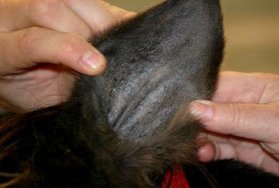Ear Plaques and Sarcoid Tumors
Skin conditions are common issues in equine practice. Among those brought to my attention are Ear Plaques and Sarcoid Tumors.
Ear Plaques
Everyone has seen a horse whose ears have unsightly ear plaques. Inside the ear are white flat plaques. They only appear MORE visible when a horse's ears are clipped to make him or her attractive for a competition. They seem to be caused by a wart virus and can be spread by biting flies.
Ear plaques before treatment
Unlike the warts seen on young horses, they don't go away within a few months. For years people have asked me about treating them. While many treatments have been tried, there was none proven effective. Often the only result was an ear shy horse. My advice has been to leave it alone.
Until now!
Recent research showed that treatment with a topical cream of the drug imiquimod can resolve ear plaques. The treatment does not work in all horses and does not resolve all cases. But, unlike in the past, it does work in many cases. Either plaques are complete gone or diminished along with the ear sensitivity that can accompany them.
Ear plaques after treatment
Imiquimod works by stimulating a local inflammatory response and encouraging the body's own immune system to rid itself of the plaque.
The ear is treated two to three times per week every other week for two to three months, then reassessed.
When treating a horse the inflammatory response can create redness swelling and oozing.
Ear plaques during treatment responding with inflammation
Horses don't seem to resent the treatment but prior to treatment the crusts and gunk that develop must be removed. Some horses do resent that and may need to be sedated.
One choice for sedation is also new. Dermosedan(R), a common sedative I use intravenously, is now available in a oral gel. Given under the tongue it has been shown to be very effected in accomplishing minor uncomfortable procedures without the need to give an injection.
A way to help reduce resistance is to soften the crusts with baby oil prior to trying to treating them.
With all the treatment to the ears you might suspect horses would become more head shy. Fortunately, they seem to forgive us. Most of the treated horses actually become less head shy as the plaques in their ears resolve.
Sarcoids
There are a variety of treatments for Sarcoids a common skin tumor in horses that can either appear as a flat grey plaque or a solid mass on a horse's skin. Imiquimod has also been shown to be an appropriate treatment for some but not all equine sarcoids.
Sarcoid plaque on neck of a horse
Sarcoid on the upper eyelid of a horse
It is always nice when an effective treatment comes along to a problem that has been frustrating in the past. The use of Imiquimod to treat ear plaques and some sarcoids is a welcome addition to treatments I can offer to you as a horse owner with a horse having one of these conditions.






